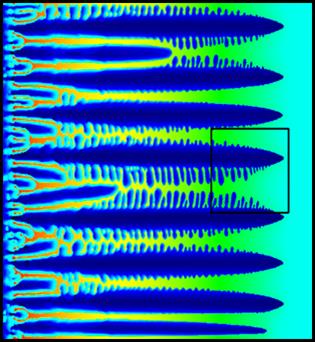Integrated Computational Materials Engineering
Contact Us
Dr. Michael Greenwood
Integrated Computational Materials Engineering Functional Group Leader,
Research Scientist
Telephone: 905-645-0786
Email: Michael.Greenwood@canada.ca

Phase field simulations of solidification. Photo by CanmetMATERIALS.
CanmetMATERIALS’ Integrated Computational Materials Engineering group studies structure-property relationships, mechanical response of materials and behaviour of multi-phase materials over a range of length scales. The team uses methods such as molecular dynamics phase field simulations and multi-physics finite element analyses:
- Cray XE6 (2112 processors): Cluster with 144 processes.
- Atomistic
- Quantum mechanics: VASP, Abinit
- Molecular dynamics: LAMMPS
- Phase field crystal: in-house
- Microstructure evolution
- Crystal plasticity: in-house, self-consistent
- Phase field: in-house
- Recrystallization: in-house
- Continuum/structural
- Finite element analysis: Abaqus, Procast
- Computed-aided design: Solidworks, Siemens NX
- Thermodynamics and kinetics
- Thermodynamics: Factsage, Thermo-Calc
- Diffusion: in-house
Examples of specific achievements include:
- Fracture and damage mechanics
- Competition between plasticity and damage processes
- Transition between flat and slant fracture correctly predicted
- Competition between plasticity and damage processes
- Recrystallization in hexagonal close packed (HCP) materials
- Crystal plasticity used to model continuous dynamic recrystallization
- Grain fragmentation correctly predicted
- Texture evolution correctly predicted
- Crystal plasticity used to model continuous dynamic recrystallization
- Yield functions for HCP materials
- Yield functions developed via linear transformation of stress tensor
- Solidification microstructure
- Phase field methods used to study dendrite growth during solidification
- Linear elasticity
- Multi-component thermodynamics
- Phase field methods used to study dendrite growth during solidification
- Molecular dynamics study of irradiation damage
- Irradiation damage studied as function of grain boundary structure and distance of incident recoil atom from grain boundary
- Defects are found to be generally absorbed by grain boundaries
Page details
- Date modified: